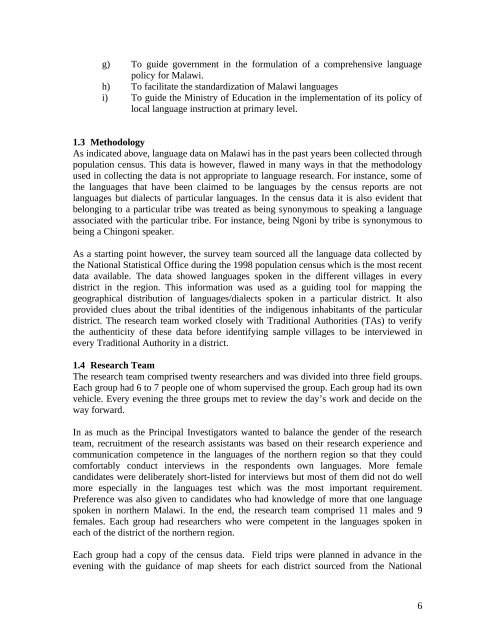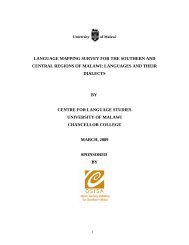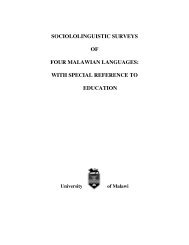languages and area spoken for chitipa - Centre for Language Studies
languages and area spoken for chitipa - Centre for Language Studies
languages and area spoken for chitipa - Centre for Language Studies
Create successful ePaper yourself
Turn your PDF publications into a flip-book with our unique Google optimized e-Paper software.
g) To guide government in the <strong>for</strong>mulation of a comprehensive language<br />
policy <strong>for</strong> Malawi.<br />
h) To facilitate the st<strong>and</strong>ardization of Malawi <strong>languages</strong><br />
i) To guide the Ministry of Education in the implementation of its policy of<br />
local language instruction at primary level.<br />
1.3 Methodology<br />
As indicated above, language data on Malawi has in the past years been collected through<br />
population census. This data is however, flawed in many ways in that the methodology<br />
used in collecting the data is not appropriate to language research. For instance, some of<br />
the <strong>languages</strong> that have been claimed to be <strong>languages</strong> by the census reports are not<br />
<strong>languages</strong> but dialects of particular <strong>languages</strong>. In the census data it is also evident that<br />
belonging to a particular tribe was treated as being synonymous to speaking a language<br />
associated with the particular tribe. For instance, being Ngoni by tribe is synonymous to<br />
being a Chingoni speaker.<br />
As a starting point however, the survey team sourced all the language data collected by<br />
the National Statistical Office during the 1998 population census which is the most recent<br />
data available. The data showed <strong>languages</strong> <strong>spoken</strong> in the different villages in every<br />
district in the region. This in<strong>for</strong>mation was used as a guiding tool <strong>for</strong> mapping the<br />
geographical distribution of <strong>languages</strong>/dialects <strong>spoken</strong> in a particular district. It also<br />
provided clues about the tribal identities of the indigenous inhabitants of the particular<br />
district. The research team worked closely with Traditional Authorities (TAs) to verify<br />
the authenticity of these data be<strong>for</strong>e identifying sample villages to be interviewed in<br />
every Traditional Authority in a district.<br />
1.4 Research Team<br />
The research team comprised twenty researchers <strong>and</strong> was divided into three field groups.<br />
Each group had 6 to 7 people one of whom supervised the group. Each group had its own<br />
vehicle. Every evening the three groups met to review the day’s work <strong>and</strong> decide on the<br />
way <strong>for</strong>ward.<br />
In as much as the Principal Investigators wanted to balance the gender of the research<br />
team, recruitment of the research assistants was based on their research experience <strong>and</strong><br />
communication competence in the <strong>languages</strong> of the northern region so that they could<br />
com<strong>for</strong>tably conduct interviews in the respondents own <strong>languages</strong>. More female<br />
c<strong>and</strong>idates were deliberately short-listed <strong>for</strong> interviews but most of them did not do well<br />
more especially in the <strong>languages</strong> test which was the most important requirement.<br />
Preference was also given to c<strong>and</strong>idates who had knowledge of more that one language<br />
<strong>spoken</strong> in northern Malawi. In the end, the research team comprised 11 males <strong>and</strong> 9<br />
females. Each group had researchers who were competent in the <strong>languages</strong> <strong>spoken</strong> in<br />
each of the district of the northern region.<br />
Each group had a copy of the census data. Field trips were planned in advance in the<br />
evening with the guidance of map sheets <strong>for</strong> each district sourced from the National<br />
6





